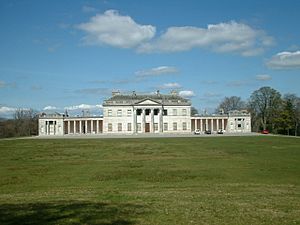Armar Lowry-Corry, 1st Earl Belmore facts for kids
Armar Lowry-Corry, 1st Earl Belmore (born April 7, 1740 – died February 2, 1802) was an important Irish nobleman and politician. A nobleman is a person from a high-ranking family, and a politician is someone involved in how a country is governed. He was known for building the grand Castle Coole.
Contents
Early Life and Family Roots
Armar Lowry was born as the first son of Galbraith Lowry. His family lived in Ahenis, County Tyrone. His mother, Sarah Corry, was connected to the Corry family of Castle Coole in County Fermanagh. Later, Armar added "Corry" to his name to honor this family connection and his inheritance.
A Career in Politics
In 1768, Armar Lowry became a member of the Irish House of Commons, which was like the parliament for Ireland at the time. He represented County Tyrone. He stayed in this role until 1781.
Rising Through the Ranks
Armar Lowry was given several special titles:
- In 1781, he became Baron Belmore. This was a title in the Peerage of Ireland, a system of noble ranks.
- In 1789, he was made Viscount Belmore.
- In 1797, he received his highest title, Earl Belmore.
He also served as the High Sheriff for County Tyrone in 1769 and for County Fermanagh in 1779. A High Sheriff was a local official responsible for law and order.
Building Castle Coole
In 1774, Armar Lowry inherited the beautiful Castle Coole estate from the Corry family. He then added "Corry" to his name. Lord Belmore had big plans for his family's political future, and rebuilding Castle Coole was a key part of these plans.
A Grand Design
Castle Coole is seen as one of the most magnificent classical houses built in Ireland during the 1700s. It was designed by a famous architect named James Wyatt. People believed that Lord Belmore built such a grand house to show off his important position in Irish society and his power in the Irish Parliament. The house was meant to be a symbol of his family's influence.
Political Hopes and Changes
Lord Belmore was very confident about his political future when he built Castle Coole. However, things changed. In 1800, the Act of Union 1800 was passed. This law joined Ireland with Great Britain, and the Irish Parliament was closed. This meant Lord Belmore lost his chance for more political power.
Even though he owned a lot of land (about 70,000 acres) and earned a good income from it, building Castle Coole was very expensive. It cost about £70,000, which was a huge amount of money back then. The house was finished during his lifetime, but it wasn't fully furnished until his son took over the estate.
Family Life
Lord Belmore was married three times.
First Marriage
On October 3, 1771, he married Lady Margaret Butler. They had two sons:
- Galbraith Lowry-Corry (who died young)
- Somerset Lowry-Corry, 2nd Earl Belmore (who later inherited his father's titles)
Second Marriage
His second marriage was on March 2, 1780, to Lady Harriet Hobart. She was the daughter of John Hobart, 2nd Earl of Buckinghamshire, who was the Lord Lieutenant of Ireland at the time. They had one daughter:
- Lady Louisa Mary Anne Julia Harriet Lowry-Corry (born 1781). She later married George John Montagu, 6th Earl of Sandwich and had children.
Lord Belmore's second marriage ended in 1793.
Third Marriage
On March 1, 1794, he married Mary Anne Caldwell. She was the daughter of Sir John Caldwell, 4th Baronet.
Lord Belmore passed away in Bath on February 2, 1802, at the age of 61. His only surviving son, Somerset, inherited his titles and estates.
Images for kids



